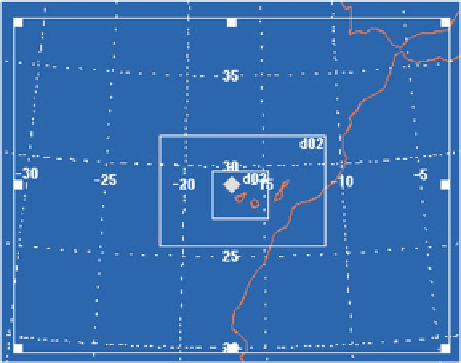Environmental Engineering Reference
In-Depth Information
The aim of the present work is to reproduce this weather phenomenon using the
WRF-ARWNWP model and analyze the sensitivity to the horizontal high-resolution
mesoscale meteorological modelling and the nonhydrostatic option.
2 Methods
TheWeather Research and Forecasting (WRF)Model v2.1.2 (Michalakes et al.
2005
)
was used to simulate the wind field over the Canary Islands under the Delta meteoro-
logical situation. WRF was configured with the ARW dynamics solver (Skamarock
et al.
2005
) to integrate the primitive equations. The physical parameterizations used
were: single-moment 3-class scheme for the microphysics processes, Kain-Fritsch
scheme for cumulus parameterization, the Rapid Update Cycle model Land-Surface
scheme with 6 sub-soil layers (Smirnova et al.
1997
,
2000
), the Yonsei University
PBL scheme (Noh et al.
2003
), the long-wave radiative processes are parameterized
with the Rapid Radiative Transfer Model following Mlawer et al. (
1997
) and the
short-wave radiative scheme based on Dudhia (
1989
).
Three domains were defined using two-way nesting technique interaction. The
domains were centered over the Canary Islands with 300
×
230, 340
×
226 and
337
292 grid points for the outer to inner domains, respectively. The location of
the meshes is shown in Fig.
2
. The horizontal resolutions were 9, 3, 1km with 40
sigma vertical levels, 11 characterizing the boundary layer. Themodel topwas fixed at
50hPa. Analysis of the EuropeanCenter forMediumWeather Forecasts (ECMWF) at
00:00 UTC November 28 was used as the initial condition. The boundary conditions
were provided by the ECMWF forecasts at 3h intervals from 03:00 UTC November
28 to 00:00 UTC November 30. The ECMWF data used a spatial resolution of 25km
derived from the T799 model forecasts.
×
Fig. 2
Definition of the
three nested model domains

Search WWH ::

Custom Search